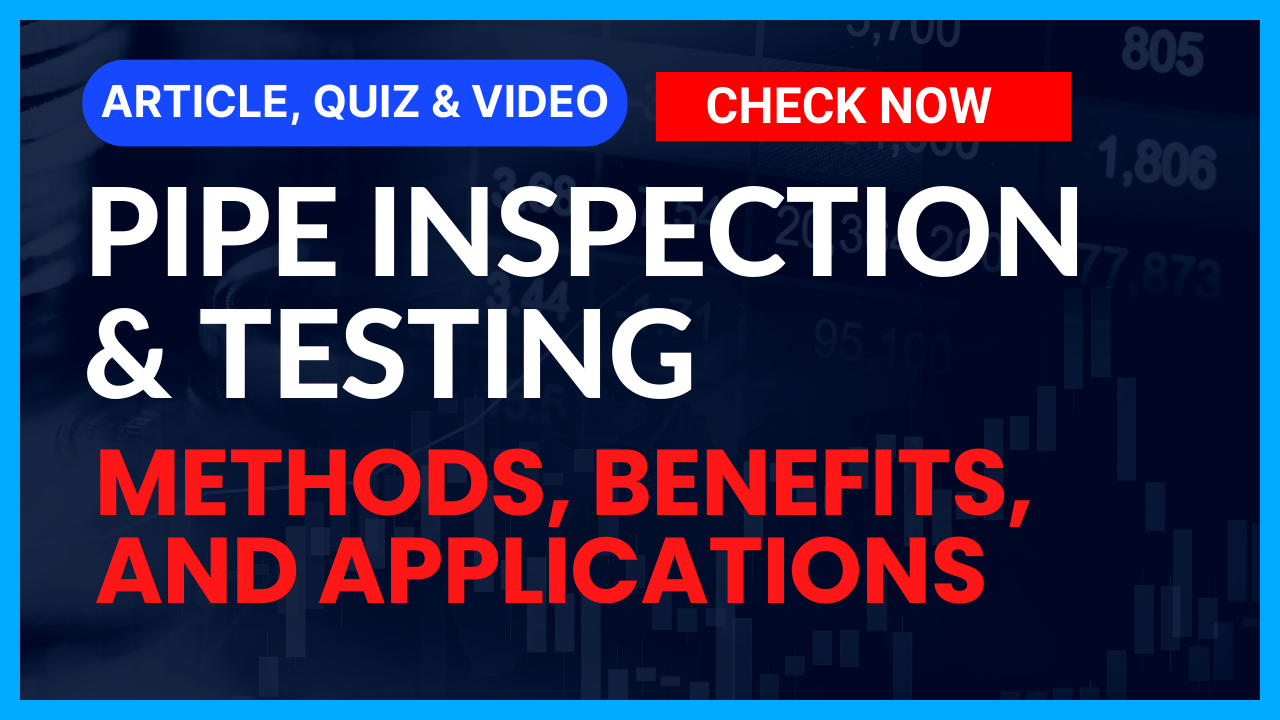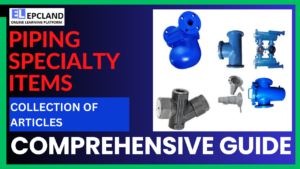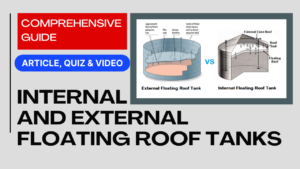Introduction
Pipelines play a vital role in modern society by transporting essential resources such as water, oil, gas, and chemicals. To maintain their functionality and prevent potential disasters, regular pipe inspection and testing are paramount. In this comprehensive guide, we will explore the significance of pipe inspection and testing, delve into various methods employed, highlight emerging technologies, and address common questions regarding this critical process.
Table of Contents
Don’t miss the Complete Course on Piping Engineering: Check Now
By EPCLand.com
Importance of Pipe Inspection and Testing
Pipelines are the unsung heroes of infrastructure, quietly enabling the functioning of cities, industries, and economies. Ensuring their reliability and integrity through inspection and testing holds several crucial benefits:
Preventing Environmental Disasters
The environment is at risk when pipelines fail. Leaks can lead to catastrophic soil and water contamination, affecting ecosystems and endangering public health.
Ensuring Public Safety
Faulty pipelines pose grave safety threats to communities and workers. Identifying issues proactively prevents accidents, explosions, and potential loss of life.
Prolonging Pipeline Lifespan
Routine inspection and testing allow the early identification of minor defects, addressing them before they escalate into major problems. This practice extends the lifespan of pipelines, minimizing costly replacements.
Methods of Pipe Inspection and Testing
Various techniques are employed to assess pipeline integrity and identify potential problems. Here are some common methods:
Visual Inspection
Visual inspections involve physically examining pipelines for visible signs of corrosion, cracks, or leaks. It is a fundamental method that serves as a preliminary assessment.
Ultrasonic Testing
Ultrasonic waves are used to detect internal defects in pipelines. This non-destructive method is especially useful for identifying hidden issues.
Magnetic Particle Inspection
This technique detects surface and near-surface defects in ferromagnetic materials by analyzing changes in magnetic fields after applying magnetic particles.
Pressure Testing
By subjecting pipelines to higher-than-normal pressures, pressure testing assesses their ability to withstand operational conditions and identifies potential weaknesses.
Understanding Visual Pipe Inspection
Visual pipe inspection involves using the human eye or optical devices to conduct a direct assessment of a pipeline’s external condition. It’s the equivalent of a doctor’s physical examination for pipelines. This method aims to identify visible signs of wear, corrosion, leaks, and other issues that could jeopardize the pipeline’s functionality and safety.
The Process
Trained inspectors or technicians carefully examine the pipeline’s surface, joints, connections, and fittings. They’re on the lookout for irregularities, rust, cracks, deformations, and any signs of damage. By conducting a comprehensive visual assessment, inspectors can quickly identify surface-level defects that might require further investigation or remediation.
Applications
Visual inspection finds its application across various industries, including:
- Oil and Gas: To assess the condition of pipelines transporting valuable resources.
- Water Utilities: To ensure the safety and quality of water supply.
- Industrial Processes: To maintain the integrity of pipelines used in manufacturing and processing.
- Environmental Monitoring: To prevent leaks and protect ecosystems.
Don’t miss the Complete Course on Piping Engineering: Check Now
By EPCLand.com
Benefits of Visual Pipe Inspection
Early Detection
By catching issues in their early stages, visual inspection prevents minor anomalies from evolving into major problems. Addressing defects promptly reduces the risk of catastrophic failures and the associated financial and environmental consequences.
Cost-Effectiveness
Visual inspection is a cost-effective method compared to more complex testing techniques. It offers a quick initial assessment that guides decisions on further actions, potentially saving on unnecessary testing expenses.
Safety Enhancement
Routine visual inspections contribute to the safety of workers, the public, and the environment. Identifying weak points before they lead to accidents safeguards lives and reduces the potential for hazardous leaks.
Preventive Maintenance
Visual inspection is an integral part of preventive maintenance programs. Regular assessments help pipeline operators stay proactive in addressing issues and extend the overall lifespan of their assets.
Pros and Cons of visual pipe inspection
| Pros of Visual Pipe Inspection | Cons of Visual Pipe Inspection |
|---|---|
| Early Detection: Quickly identifies surface-level defects, preventing minor issues from escalating into major problems. | Limited Depth: Only assesses external conditions; internal anomalies may go undetected. |
| Cost-Effective: Provides a relatively inexpensive initial assessment, guiding decisions on further testing or maintenance. | Subjective Interpretation: Inspection relies on the skills and experience of inspectors, which can lead to variations in assessments. |
| Safety Enhancement: Contributes to worker safety by identifying potential hazards before they cause accidents or leaks. | Surface-Only: Doesn’t address issues within the pipeline material, which may require more invasive testing. |
| Preventive Maintenance: Part of proactive maintenance programs, extending the overall lifespan of pipelines. | Environmental Limitations: External inspections may not catch leaks that haven’t reached the surface yet. |
| Quick Process: Offers a swift way to assess pipeline conditions, enabling timely decision-making. | External Factors: Weather conditions or external factors might hinder visibility and inspection accuracy. |
| Documentation: Provides visual evidence of pipeline conditions for record-keeping and comparison over time. | Specialized Training: Requires trained inspectors familiar with pipeline defects and anomalies. |
| Accessibility: Can be performed without interrupting pipeline operations or causing significant disruptions. | Surface Deception: Some anomalies might appear harmless on the surface but have underlying structural implications. |
| Non-Destructive: Doesn’t harm the pipeline during inspection, preserving its integrity. | Inadequate for Some Defects: May not detect hairline cracks or corrosion beneath coatings or deposits. |
The Role of Technology
Advancements in technology have enhanced the effectiveness of visual pipe inspection:
Remote Visual Inspection (RVI)
Cameras mounted on robotic systems allow inspectors to assess pipelines in remote or hard-to-reach areas. RVI minimizes the need for extensive excavation or human entry, ensuring inspections are thorough and safe.
High-Resolution Imaging
High-definition cameras capture detailed images of pipeline surfaces. These images provide valuable insights into the condition of the pipeline and serve as documentation for future reference.
Advanced Lighting
Innovative lighting techniques, such as adjustable LEDs, enable inspectors to illuminate the pipeline’s surface effectively, enhancing the visibility of potential defects.
Emerging Technologies in Pipe Inspection
The landscape of pipe inspection is evolving with innovative technologies that enhance accuracy and efficiency:
Pipeline Inspection Gauges (PIGs)
PIGs are robotic devices equipped with sensors and cameras that navigate pipelines, capturing data and identifying defects, even in challenging areas.
Digital Imaging and 3D Scanning
Advanced imaging and 3D scanning provide detailed visual representations of pipeline interiors, enabling the detection of defects that might go unnoticed otherwise.
Guided Wave Ultrasonics
Utilizing low-frequency ultrasonic waves, guided wave ultrasonics can inspect extended pipeline sections for corrosion and erosion in difficult-to-reach locations.
FAQs About Pipe Inspection and Testing
FAQ 1: How frequently should pipelines undergo inspection?
Pipelines should be inspected annually as a minimum standard. However, factors like pipeline age, material, and content being transported might necessitate more frequent checks.
FAQ 2: What regulations govern pipeline inspection?
Regulatory bodies such as the Pipeline and Hazardous Materials Safety Administration (PHMSA) establish guidelines for pipeline inspection, ensuring compliance and safety.
FAQ 3: Can inspections occur while pipelines are operational?
Yes, many inspection methods are designed for in-operation assessment. Technologies like PIGs and guided wave ultrasonics can function without disrupting pipeline functionality.
FAQ 4: How are detected defects managed?
The severity and location of defects determine the course of action. Minor issues might be addressed during routine maintenance, while significant defects require immediate repair or replacement.
FAQ 5: How accurate are modern inspection technologies?
Modern technologies are remarkably accurate, capable of identifying even the smallest irregularities. Their precise data aids in informed decision-making for maintenance.
Conclusion
Pipe inspection and testing are the unsung heroes behind the scenes of our interconnected world. Their role in maintaining environmental safety, public security, and infrastructure longevity cannot be overstated. By utilizing a range of inspection methods and embracing emerging technologies, we safeguard our pipelines, ensuring they continue to serve us reliably for years to come.
Recommended courses (Published on EPCLand)
- Basics of Piping Engineering
- Piping Layout Engineering
- Piping Material Engineering
- Piping Stress Analysis
- Complete Course on Piping Engineering
- Material Requisitions
- Piping Material Specifications
- Valve Material Specifications
Don’t miss the published articles on following:
Related Video
Attempt Quiz
Question 1:
What is the main purpose of pipe inspection and testing?
Explanation: The main purpose of pipe inspection and testing is to ensure the structural integrity and safety of pipes, preventing potential failures and hazards.
Question 2:
Which non-destructive testing (NDT) method uses sound waves to detect flaws in pipes?
Explanation: Ultrasonic Testing (UT) uses sound waves to detect internal and surface flaws in pipes, making it effective for assessing the quality and integrity of materials.
Question 3:
Which destructive testing method involves cutting and examining a section of pipe?
Explanation: Impact Testing (IT) involves breaking a section of pipe to assess its ability to withstand sudden loading or impact. This method is considered destructive as it destroys the test specimen.
Question 4:
What is hydrostatic testing?
Explanation: Hydrostatic testing involves pressurizing pipes with high-pressure water to check for leaks, assess structural integrity, and ensure that pipes can withstand their intended operating pressures.
Question 5:
Which type of inspection is carried out during the manufacturing process of pipes?
Explanation: In-process inspection is carried out during the manufacturing process of pipes to monitor quality at various stages, ensuring that any defects or issues are identified and addressed before completion.


